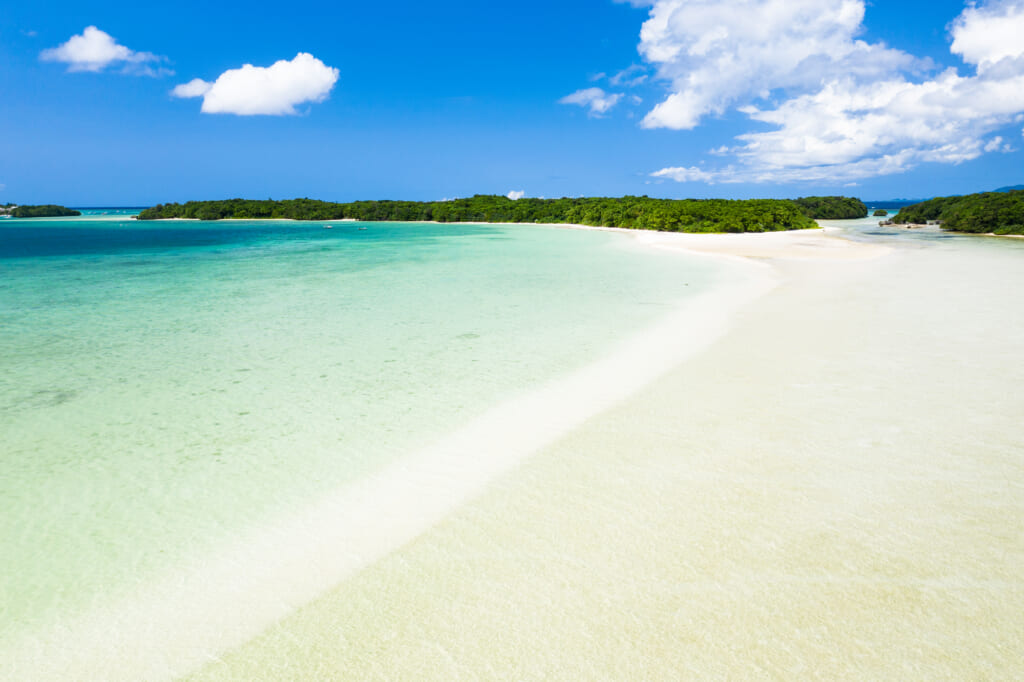
The Heart of the Yaeyama Islands
Ishigaki Island (石垣島) is the vibrant center of the Yaeyama archipelago, located in the far south of Okinawa Prefecture. With its turquoise seas, dramatic mountains, and rich cultural traditions, Ishigaki serves as both the gateway to the Yaeyama Islands and a destination full of experiences in itself. Unlike Okinawa Honto, Ishigaki retains a balance between modern facilities and untouched natural beauty, making it the perfect place for travelers who want comfort while still feeling like true explorers.
Ishigaki Island, part of Okinawa Prefecture’s Yaeyama archipelago, is where subtropical Japan meets turquoise waters and vibrant island culture. About 50,000 people call Ishigaki home, most of them in Ishigaki City, the island’s lively hub with restaurants, shops, and accommodations.
Beyond the city, Ishigaki unfolds into a landscape of sugarcane fields, pineapple farms, mangrove forests, and hidden white-sand beaches. The countryside is also home to Ishigaki cattle and natural treasures like the Yaeyama Palm Tree Grove, a nationally protected natural monument. Whether you’re here to relax on the sand, dive among coral reefs, or immerse yourself in island culture, Ishigaki makes the perfect base for exploring the Yaeyama Islands. Ferries from Ishigaki connect you to Taketomi, Iriomote, Hateruma, Kohama, and more — each with its own unique character.
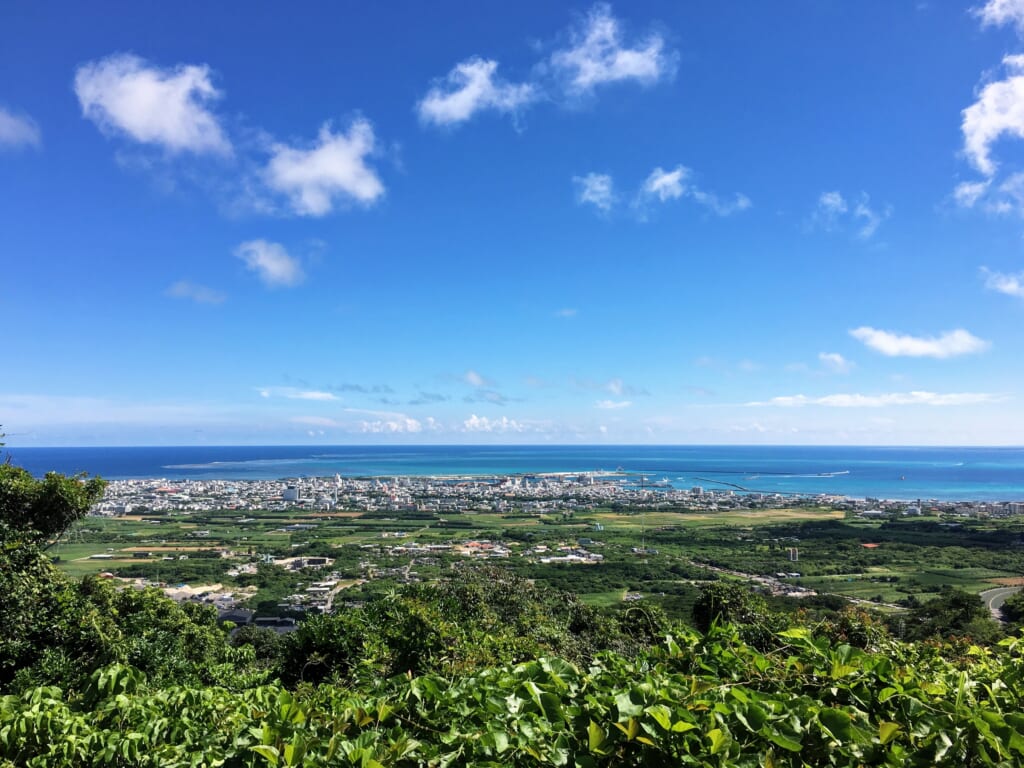
Why Ishigaki is the Center of the Yaeyama Islands
Ishigaki is not only the largest and most developed island of the Yaeyama archipelago but also its geographical, cultural, and logistical hub.
Gateway by Air: New Ishigaki Airport (南ぬ島石垣空港) connects the Yaeyamas to Tokyo, Osaka, Fukuoka, Naha, and even Taiwan, making it the only true entry point by plane.
Gateway by Sea: Ferries from Ishigaki Port connect travelers to Taketomi, Iriomote, Kuroshima, Hateruma, and Yonaguni. Every island-hopping trip starts here.
Urban & Administrative Hub: Ishigaki City is the largest town in the Yaeyamas, home to hospitals, schools, government offices, shopping centers, and restaurants. Residents from the outer islands come here for essential services.
Cultural Anchor: Many Yaeyama festivals, craft traditions, and food specialties are centered in Ishigaki, spreading influence across the archipelago.
Beaches & Snorkeling Spots
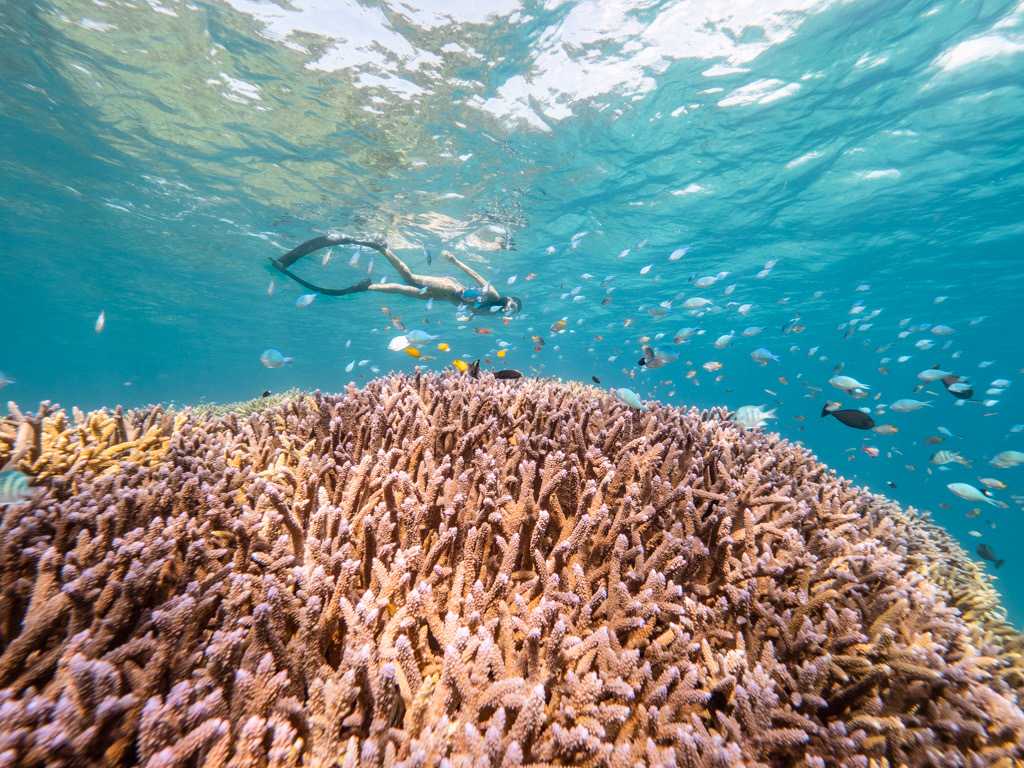
Snorkeling at Yonehara Beach reveals colorful coral gardens just meters from shore.
Kabira Bay (川平湾)
One of Japan’s most famous scenic spots, Kabira Bay is a must-see. Its emerald waters dotted with white sand islands make it postcard-perfect. Swimming is prohibited due to strong currents, but you can enjoy glass-bottom boat rides to see colorful coral and tropical fish.
Yonehara Beach
Ishigaki’s top snorkeling spot. Colorful coral gardens start just offshore — great for beginners and families. Facilities include showers, toilets, and even a campground.
Sukuji Beach
Shallow, calm waters with nets make this beach ideal for young children. Less vibrant for snorkeling but great for swimming and relaxing. The shallow waters and shaded pine trees make it a perfect picnic spot.
Hirakubo Peninsula & Sunset Beach
Secluded northern beaches with breathtaking views, perfect for sunset photography.
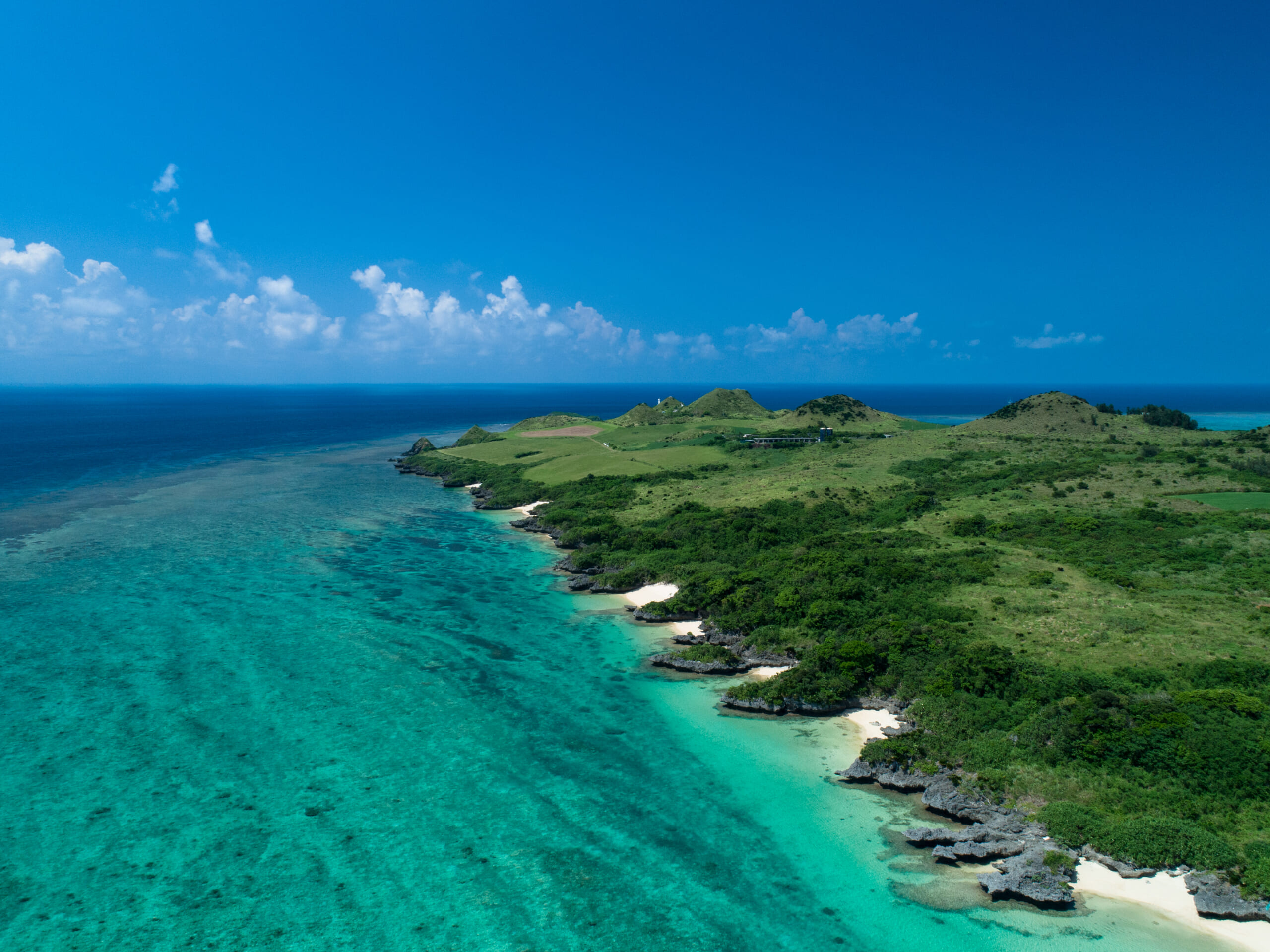
Secluded beaches in Hirakubo peninsula
⇒Safety Tip for Swimmers
Always swim with awareness — and whenever possible, with company. From May to October, watch out for dangerous jellyfish. And don’t forget to use reef-safe sunscreen — it protects both your skin and Ishigaki’s fragile coral reefs.
Nature & Hiking
Ishigaki is more than beaches. The Yaeyama Mountains and mangroves offer hiking and kayaking adventures.
Mt. Omoto (於茂登岳): Okinawa’s highest peak at 526m. Hiking trails lead through subtropical forests with panoramic views.
Miyara River (宮良川): Famous for mangrove kayaking, where you can spot crabs, birds, and other wildlife.
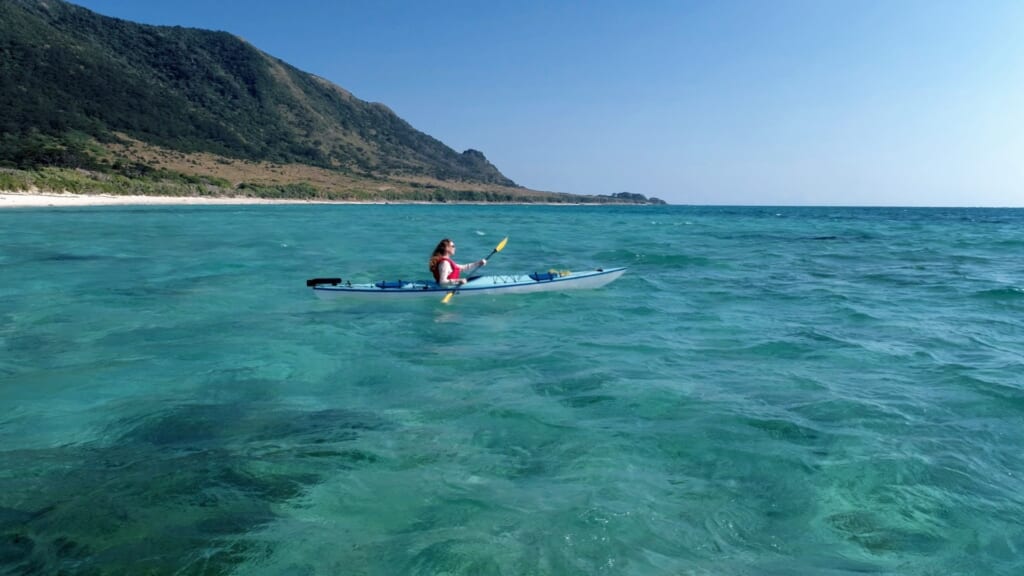
Culture & Traditions
Ishigaki is not just nature—it’s deeply rooted in Yaeyama and Ryukyu culture.
Yaeyama Soba: A local take on Okinawa soba with thinner noodles and flavorful pork broth.
Festivals: Events like Angama (bon festival dance) and Shichi (harvest rituals) reveal the island’s spiritual traditions.
Crafts: Ishigaki is known for Yaeyama minsa weaving, pottery, and music using the sanshin.
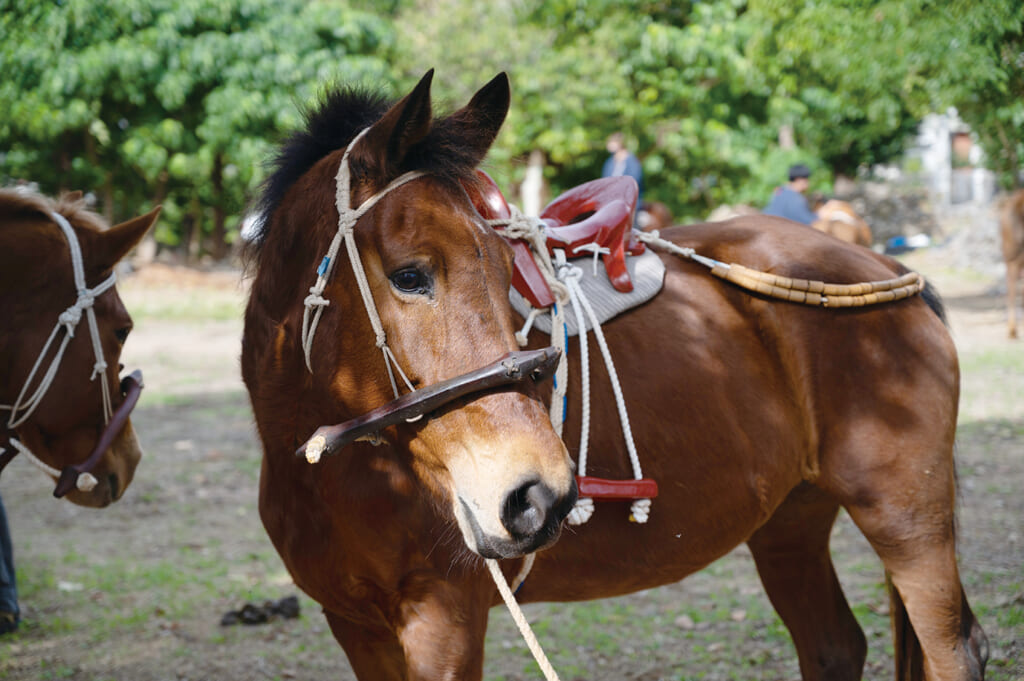
Top Things to Do in Ishigaki Island
Kabira Bay – Ishigaki’s Most Iconic View
Kabira Bay on the north coast is Ishigaki’s postcard view: emerald water, white sand, and lush green islets floating in the sea. It’s so beautiful that it’s listed among the Top 100 Scenic Spots of Japan.
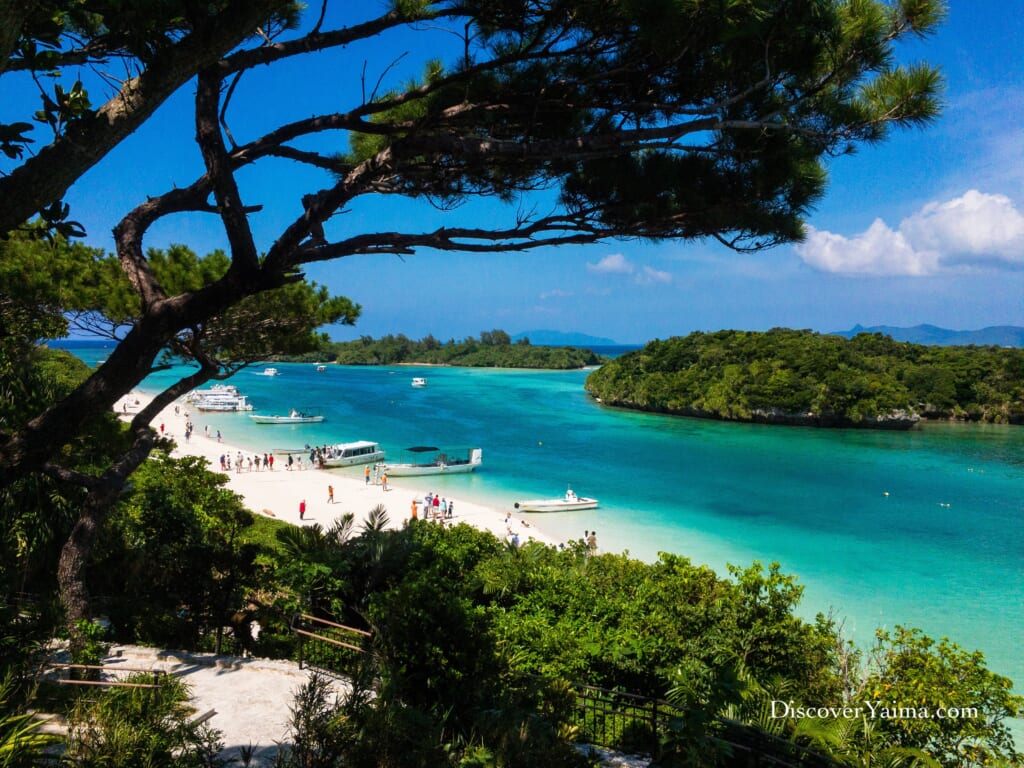
Kabira Bay’s emerald waters are Ishigaki’s most iconic view – best admired by glass-bottom boat.
No swimming allowed here (to protect coral and pearl cultivation), but you can enjoy the bay by glass-bottom boat tours (¥1,000–1,200) that reveal coral gardens and tropical fish.
Kabira is also famous for black pearl farming — one of the few places in Japan where they’re cultivated. Visit the pearl shop near the bay for displays and jewelry.
Nearby Kabira village has cafés, like one of our favorites Joo Chiat, Okinawan restaurants and small souvenir shops — great for lunch after sightseeing.
Tip: Arrive in the morning and/or at Golden hour when the light is best for photos of the turquoise water.
Hiking & Mountains – Nosoko Mape and Omoto-dake
Ishigaki isn’t just about beaches — it’s a paradise for hiking lovers.
Nosoko Mape (282m): A short but steep hike (15–45 min depending on route). The summit offers 360° views over the island, often called one of the best lookouts in Yaeyama. Be cautious after rain, as the trail gets slippery. Local legend says a maiden named Mape turned into stone here, giving the peak its name.
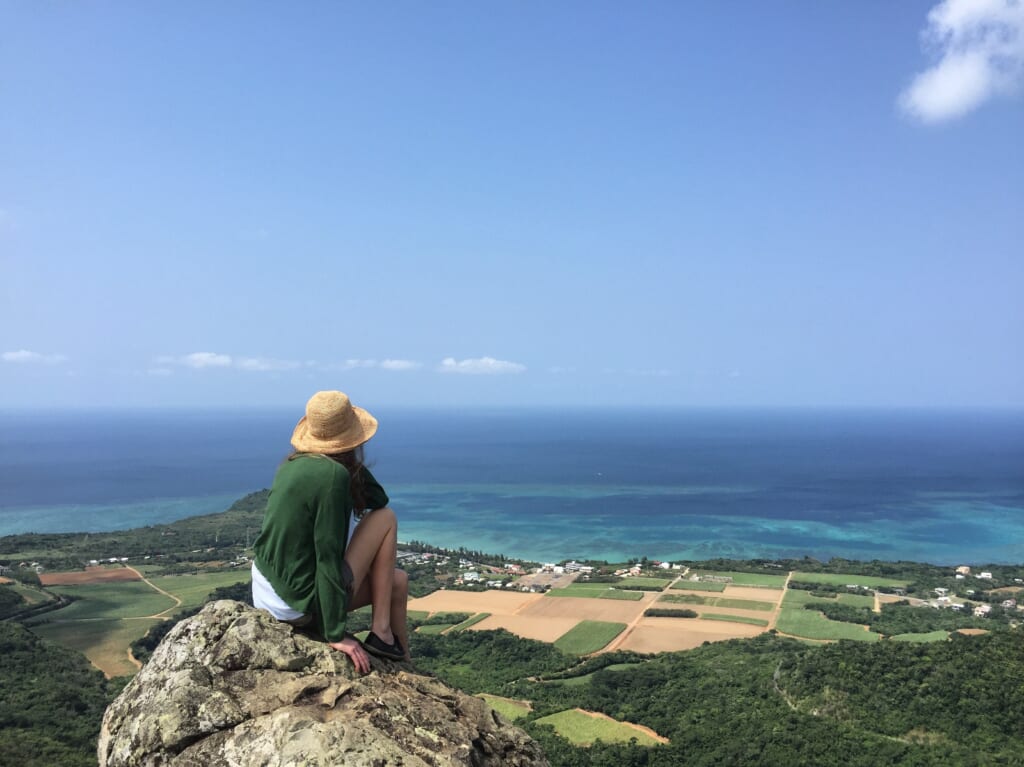
From the summit of Nosoko Mape, sweeping 360° views stretch across land and sea.
Omoto-dake (526m): The highest and sacred mountain in Okinawa Prefecture, offering a longer jungle trek.
Tip: Hiking in Ishigaki is especially rewarding in spring, autumn and winter when temperatures are comfortable. For full details, see our guide: [Best Hiking Trails in Ishigaki].
Banna Park – Family-Friendly Green Escape
If you’re visiting Ishigaki with kids, don’t miss Banna Park, just outside the city.
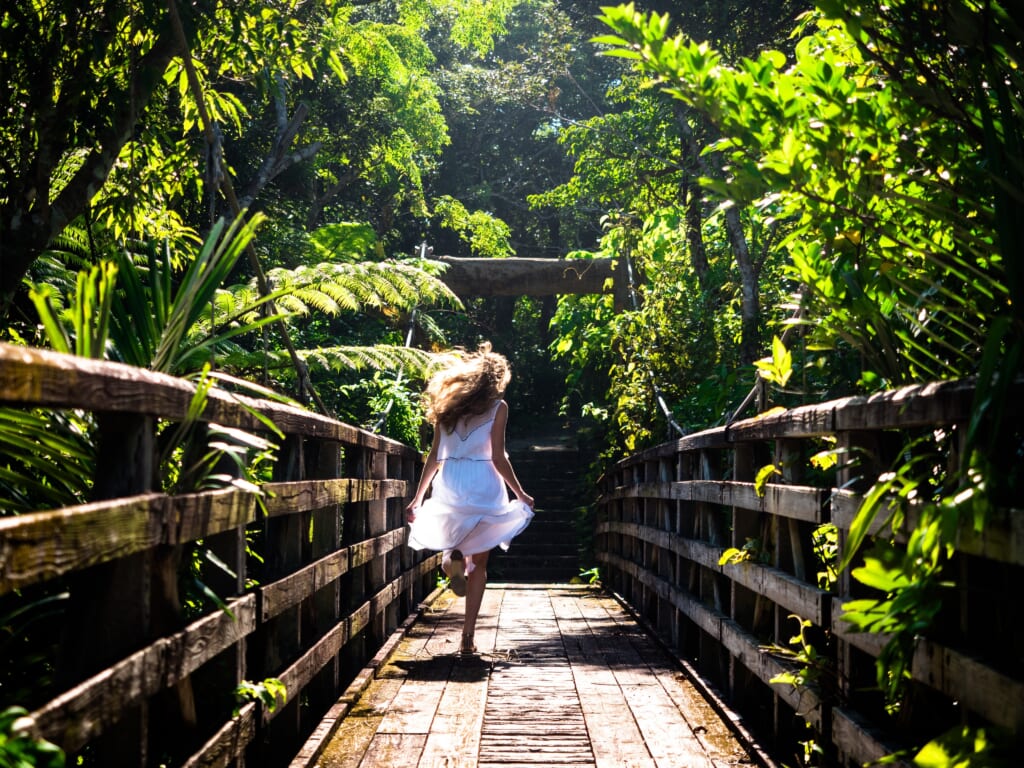
Banna Park is perfect for picnics, butterflies, and easy hikes near the city.
Spread across rolling hills, the park has walking trails, suspension bridges, observation decks, and playgrounds.
It’s famous for butterflies in spring and offers panoramic views of the city and surrounding seas.
Perfect for picnics, jogging, or letting children play.
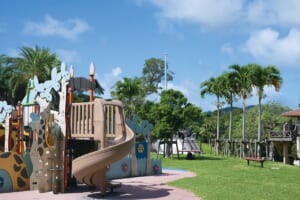
Tip: Bring snacks or lunch and enjoy a relaxed half-day surrounded by Ishigaki’s greenery.
Shopping in Ishigaki City
For a taste of island life, head to Euglena Mall (Ayapani Mall) and the Ishigaki Public Market:
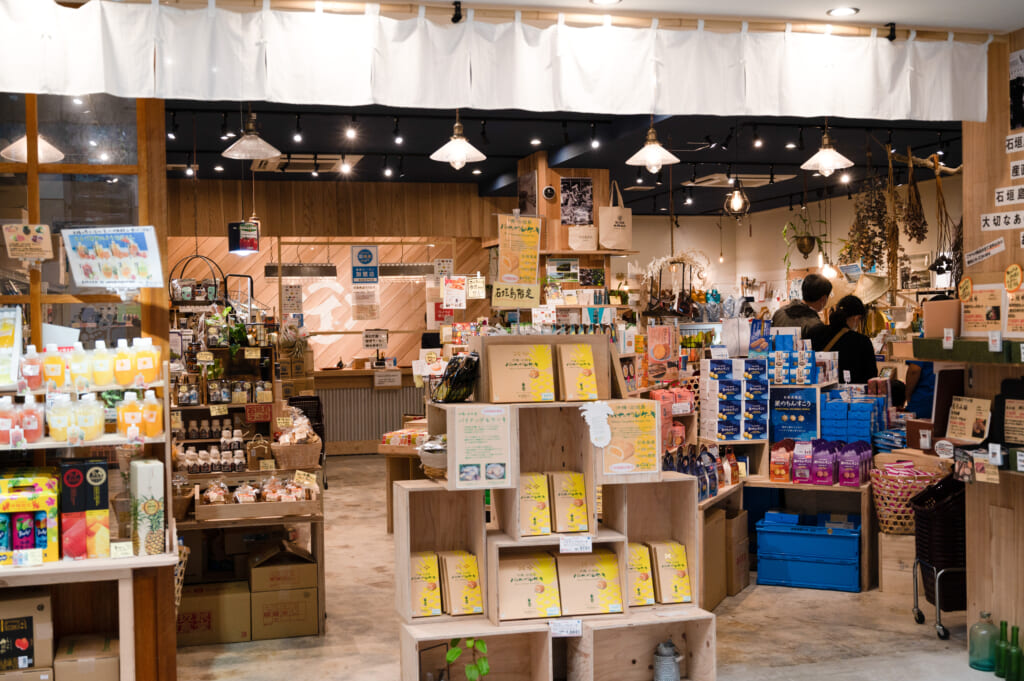
Ishigaki Public Market is packed with tropical fruits, confectionary, and handmade crafts.
Find kariyushi shirts (Okinawan aloha-style wear), glassware, chili oil, awamori liquor, and tropical fruits.
The public market sells fresh seafood, spices, and snacks. You’ll also find lovely local crafts and souvenirs in the neighbourhood shops.
Evening strolls reveal cozy izakaya pubs — Ishigaki’s nightlife is laid-back, with live Okinawan music in some bars.
Local Markets & Pottery
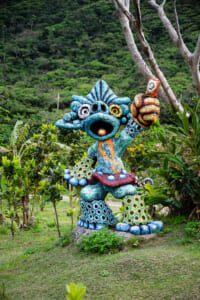
Find out about colorful shisa inside Yoneko Yaki shisa park
Shiraho Sunday Market: Farmers, artisans, and food stalls with a festival-like vibe, often with live music.
Yakimono Pottery Festival (Nov/Dec): Held at the Kengo Kuma–designed city hall, featuring Yaeyama’s top ceramic artists. Even outside festival season, shops sell unique island pottery.
- Yoneko Yaki’s Shisa park located near Yonehara beach is a fun quick (free) visit for everybody.
Festivals & Events
Ishigaki’s cultural calendar is full of vibrant traditions:
July/August & September: Obon season brings Angama dances and summer harvest festivals. Orion Beer Festival combines live music, Eisa dances, and local food.
November: The Ishigakijima Festival — the island’s largest event with parades, food stalls, and performances.
Winter: Pottery festivals, star-gazing events, and the Ishigaki Marathon.
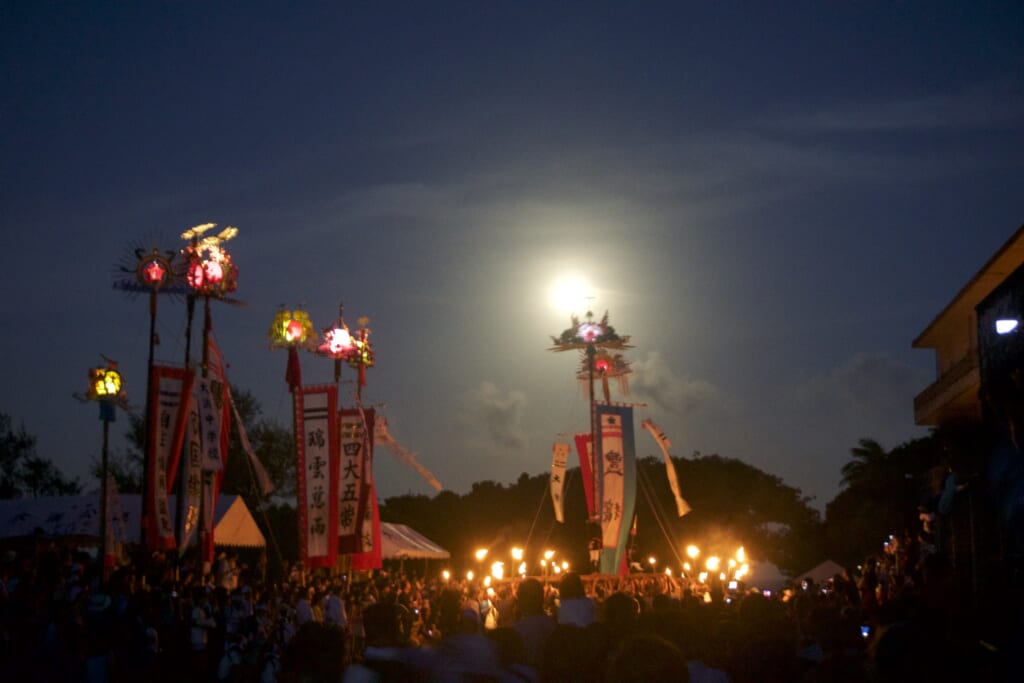
Summer harvest celebrations like Hounensai bring Ishigaki alive at sunset and moonrise
👉 Check the local calendar when planning — festivals are one of the best ways to experience Ishigaki’s culture.
Sports & Outdoor Adventures
Cycling: Ishigaki is hilly and about 130 km around. Experienced cyclists can do it in one day, or spread it across 2–3 days. Road bike rentals are available.
Marathons & Triathlons: Ishigaki hosts Japan’s southernmost marathon (January) and a triathlon in spring.
Water Activities: Kayaking, SUP, and fishing are popular.
Guided Tours & Eco Adventures
For those who prefer guided experiences:
Manta ray snorkeling/diving tours – Ishigaki is one of the best places in the world to see reef mantas.
Diving: Voted Japan’s #1 dive destination for many years. Beginners can try intro dives, while advanced divers explore deep reefs.
Mangrove kayaking & SUP: Peaceful paddles through Ishigaki’s mangrove rivers.
Stargazing tours: Ishigaki is an International Dark Sky Preserve — guides provide telescopes for an unforgettable night under the Milky Way.
Food & Drinks in Ishigaki Island
Ishigaki’s food culture blends Yaeyama traditions, island ingredients, and fresh seafood. Eating here is not just about filling up — it’s part of the experience.
Must-Try Dishes & Drinks
Yaeyama Soba: Unlike mainland soba, these noodles are made from wheat and served in a clear pork-and-katsuo broth with fish cake and pork slices. Also try the Asa soba, a delicious seaweed version. A comforting, everyday dish for locals.
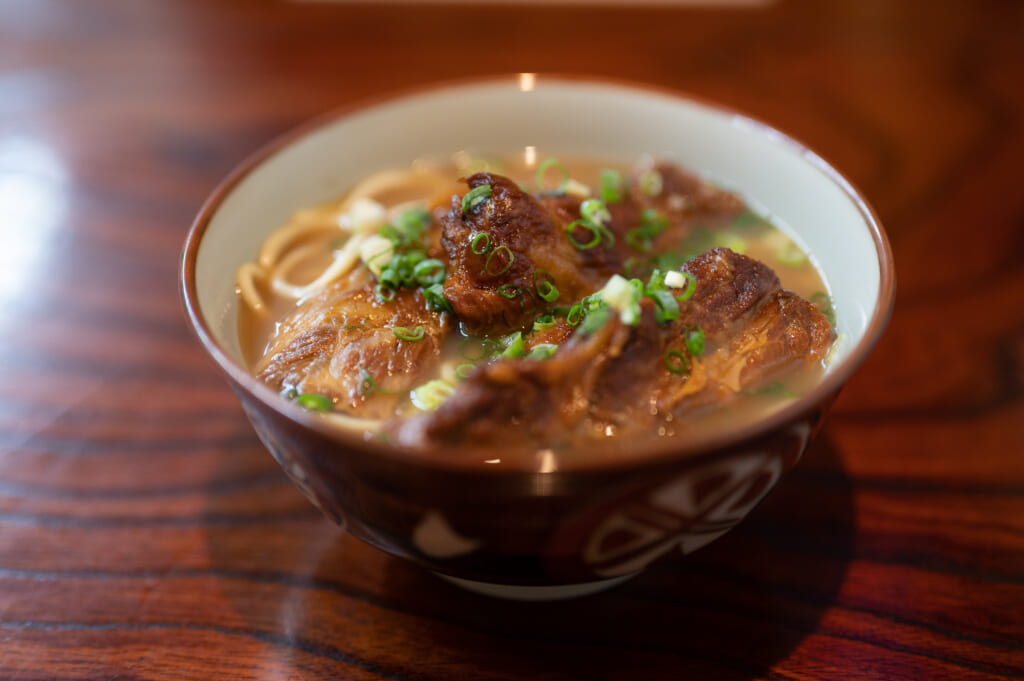
Yaeyama soba – a comforting noodle soup unique to the Okinawa islands.
The local distilled alcoholic beverage Awamori originating from Okinawa. Deeply rooted in Okinawa culture, it belongs to the same family of distilled spirits as whisky and shochu.
Umibudō (Sea Grapes): Also called “green caviar,” these seaweed clusters pop in your mouth with a salty-sweet taste of the ocean. Often served fresh with soy sauce or ponzu.
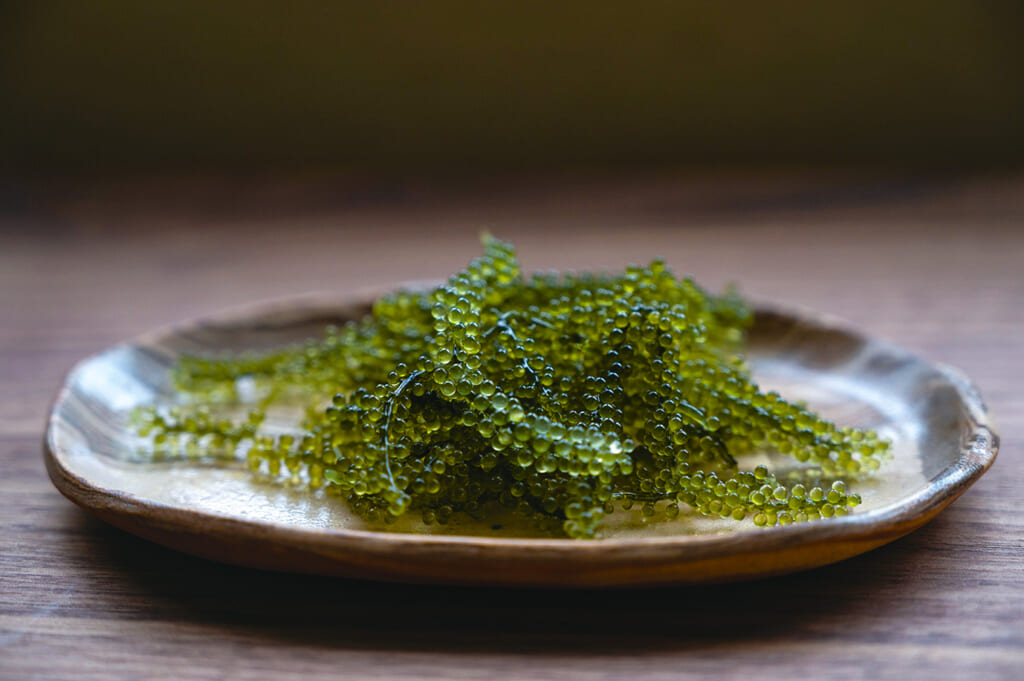
Umibudō, or “sea grapes” – bursting with ocean freshness in every bite. They could be considered the caviar of Okinawa.
Ishigaki Chili Oil (Ra-yu): A cult condiment — spicy, garlicky, and packed with umami. Locals drizzle it on everything from gyoza to pizza. Many travelers bring bottles home.
- Sweet peanut tofu and local firm Okinawa tofu
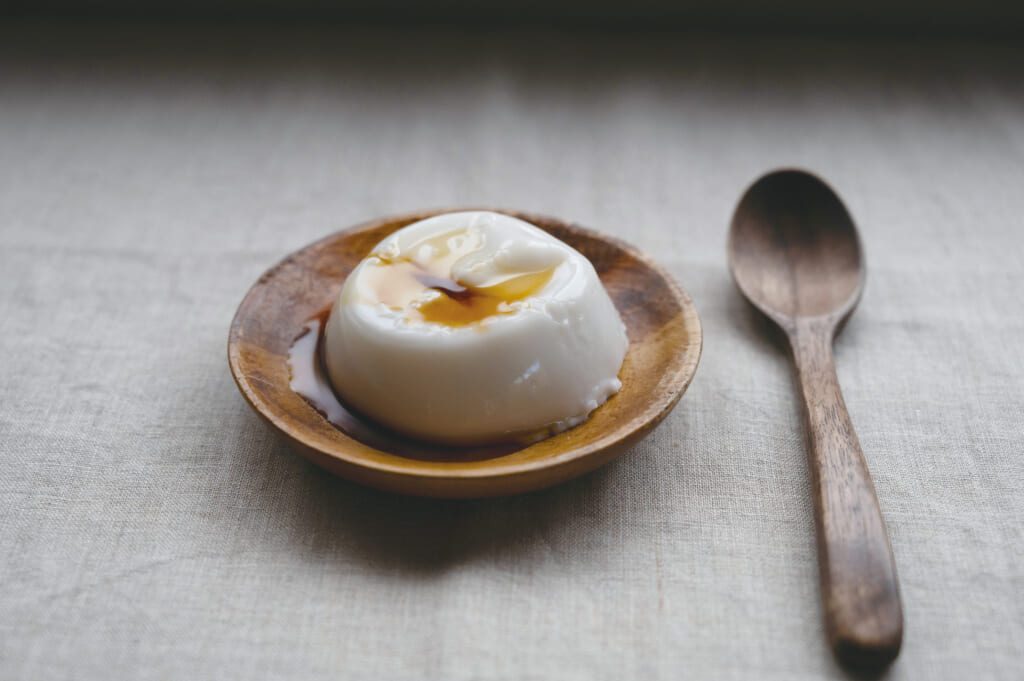
Tropical Fruits: Mango, pineapple, dragonfruit, passionfruit — often grown locally and sold at markets. Summer is peak season.
Food in Ishigaki often reflects island resilience. Because of its remote location, locals traditionally used every resource — from seaweed to pork bones — creating a cuisine that’s both simple and ingenious.
Handy Extras for Travelers
Transportation: Renting a car is highly recommended since public transport is limited. Be careful to drive on the left side of the road.
Money & Payments: ATMs are available in Ishigaki City, but remote areas may only accept cash.
Safety: Typhoon season is in summer time. Stay updated with the Japan Meteorological Agency. Emergency numbers: Police 110, Ambulance 119, Maritime 118.
Day Trips: Ferries connect to Taketomi, Iriomote, Hateruma, Kohama, etc. Ishigaki’s port makes island-hopping easy.
Best Time to Visit Ishigaki
Many travelers search for the “best season to visit Ishigaki”, so here’s a quick breakdown. For a more thorough advice check ‘Seasons and Weather’:
Spring (March–May): Warm, pleasant weather (20–27°C) with lower humidity. Ideal for hiking, sightseeing, and early snorkeling.
Summer (June–September): Hot, sunny, and vibrant (27–32°C). Best for swimming, diving, and festivals — but also typhoon season, so check the Japan Meteorological Agency for updates.
Autumn (October–November): Still warm but less humid, with calmer seas. Great for outdoor activities and fewer crowds.
Winter (December–February): Mild (18–22°C), good for hiking, cycling and sports activities and diving in local culture, food and design scene.
Tip: If you want a mix of good weather and fewer crowds, late April, early May, or October are excellent times to plan your trip.
Getting Around Ishigaki Island
Public transport is limited, so how you get around will shape your experience. Read more about transportation in The Yaeyama Islands here.
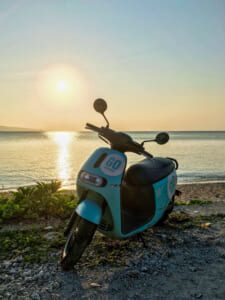
Driving along Ishigaki’s coastal roads gives you freedom to explore hidden beaches and villages.
Rental Car, motorcycle or Scooter – The most flexible way to explore. An International Driving Permit (IDP) is required (arrange it before leaving your home country). With a car or scooter you can circle the island in a day, or take a slower pace with stops at secret beaches and mountain trails.
Bus – Ishigaki does have buses, but routes outside the city are infrequent (a few per day). Fine for short trips, but not ideal for reaching the best beaches or interesting local shops & restaurants.
Bicycle – Perfect for Ishigaki City or nearby city spots. Cycling is great for soaking in the local atmosphere, though rural distances are too long and in most months too hot for most.
Taxis & Tours – Taxis are easy to find in the city. If you’re not renting a car, many tours (snorkeling, Kabira Bay, mangrove kayaking) include hotel pick-up.
Tip: If you’re visiting Ishigaki with kids, consider a rental car — it gives you shade, storage, and flexibility to explore at your own pace.
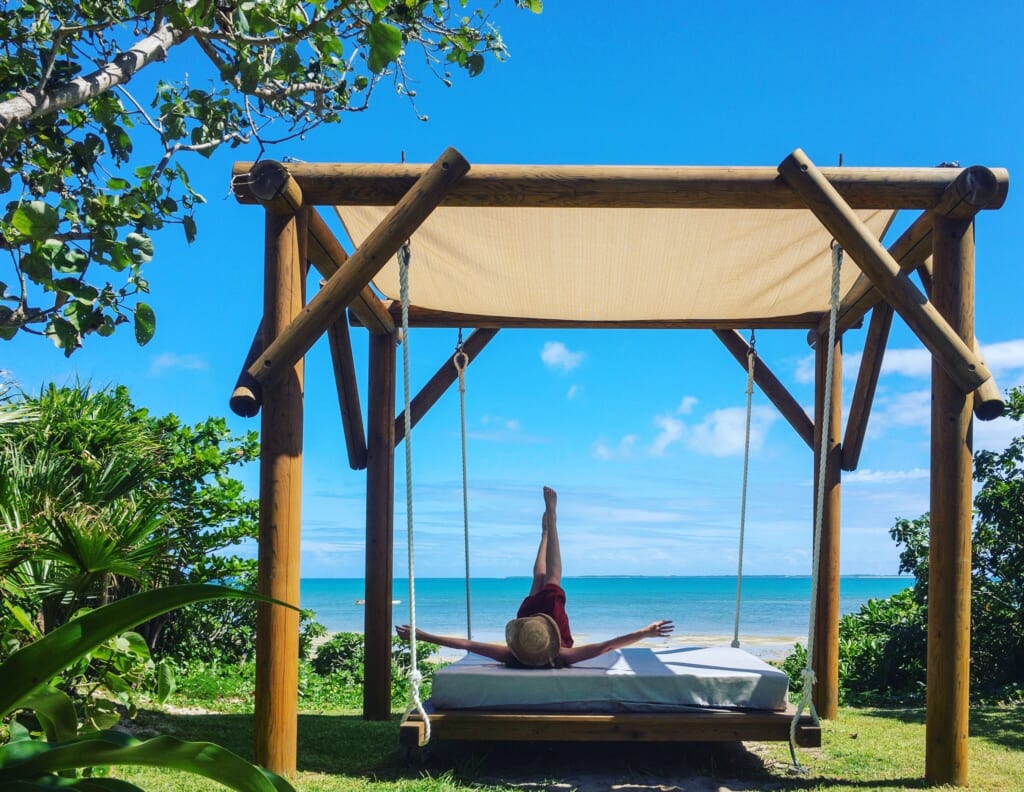
Quick Travel Tips
International Driving Permit is essential if you plan to rent a car. Be careful to drive on the left side of the road.
- Money & Payments: ATMs are available in Ishigaki City, but remote areas may only accept cash.
Book accommodations early during summer and Golden Week.
Check ferry schedules before heading to other islands.
Pack reef-safe sunscreen and bug spray — the sun and jungle are strong.
- Safety: Typhoon season is in summer time. Stay updated with the Japan Meteorological Agency. Emergency numbers: Police 110, Ambulance 119, Maritime 118.
Where to Stay in Ishigaki
Your choice of stay can shape the whole experience. Here are the main areas:
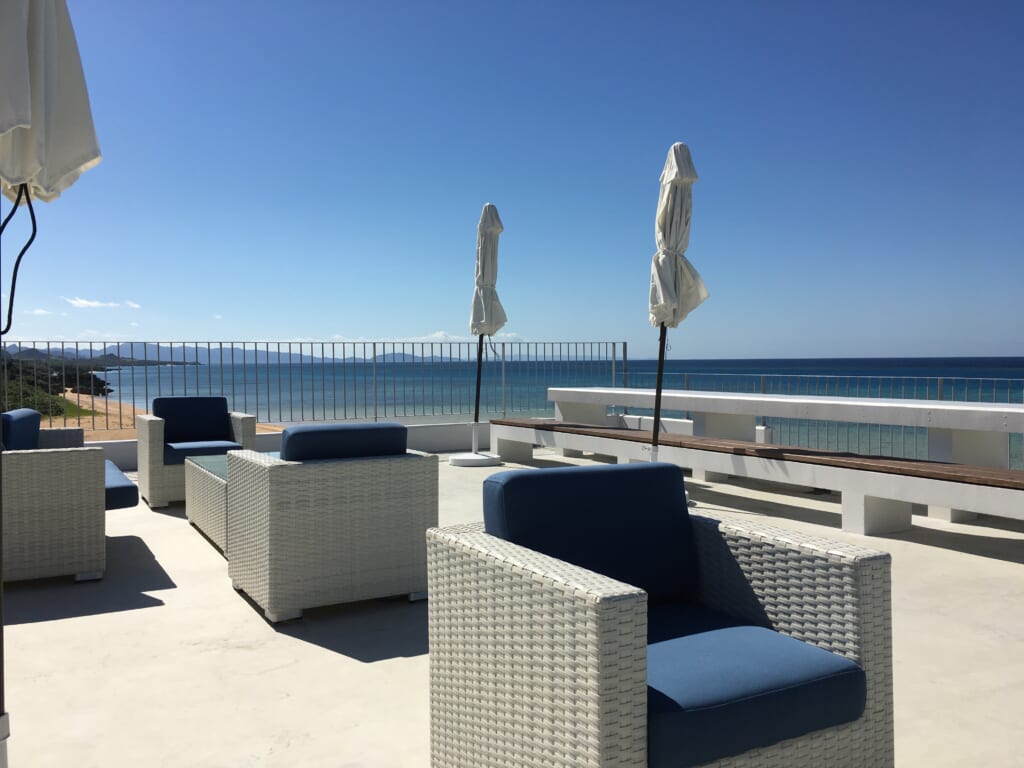
Stay in Ishigaki City for convenience, or escape to the North of Ishigaki for stunning resort views (At Seven colors).
Ishigaki City (Best for convenience): Most hotels, hostels, and guesthouses are here. Easy access to ferries, restaurants, and shops. Ideal if you plan to island-hop to Taketomi or Iriomote.
Kabira Bay Area (Best for scenery): Fewer hotels but some high-end resorts with stunning views. Perfect for honeymooners and those wanting a quieter escape.
Fusaki / Shiraho (Best for families & beaches): Family-friendly resorts with direct beach access, pools, and activities. Great if you’re traveling with kids.
Countryside Stays (Best for local immersion): Minpaku (family-run guesthouses) or eco-lodges surrounded by sugarcane and jungle. Offers a deeper cultural connection, sometimes including home-cooked meals.
Tip: Book early if visiting during summer or Golden Week (late April–early May), as accommodations fill up quickly.
Check our where to stay page too.
Why Ishigaki Will Stay With You
Traveling to Ishigaki isn’t just about visiting another island — it’s about slowing down and letting the rhythms of Yaeyama life sink in. It’s the sound of sanshin music drifting from a small izakaya, the taste of umibudō bursting like the sea on your tongue, the sight of manta rays gliding effortlessly beneath turquoise waves.
On a clear night, far from city lights, the stars reveal themselves in dazzling clarity — a reminder of how far you’ve come, and how close you feel to something timeless. Whether you’ve wandered through Kabira’s emerald bay, shared a smile at the Shiraho market, or simply watched the sun dip into the horizon, Ishigaki leaves you with moments that feel both fleeting and eternal.
It’s this blend of everyday life and natural wonder that makes Ishigaki unforgettable. And perhaps that’s why so many travelers return — not only to see more, but to feel that island spirit once again.
We’ve designed a beautiful tour around Ishigaki Island, part of the Yaeyama Islands in southern …
Plan Your Yaeyama Journey
Ishigaki is just the beginning. Each island in the Yaeyama chain has its own story:
[link: Taketomi Island Guide] – Traditional Ryukyuan village charm, with sandy lanes and water buffalo carts.
[link: Iriomote Island Guide] – A jungle-covered wilderness with waterfalls, rivers, and rare wildlife.
[link: Hateruma Island Guide] – Japan’s southernmost inhabited island, perfect for stargazing.
[link: Kohama Island Guide] – A quiet island of rolling hills and sugarcane fields.
Use Ishigaki as your gateway to Yaeyama — whether for a day trip or a longer island-hopping adventure.
Conclusion
Ishigaki Island is a destination that combines tropical paradise, cultural depth, and adventurous spirit. Whether you’re here for the beaches, hiking, food, or island-hopping, Ishigaki gives you a complete Yaeyama experience.
